Comprehensive Report: Diversity, Equity, and Inclusion in Institutions
VerifiedAdded on 2022/11/03
|13
|1134
|405
Report
AI Summary
This report delves into the multifaceted concepts of diversity, equity, and inclusion (DEI) within educational institutions. It begins by defining diversity, encompassing various dimensions like ethnicity, gender, and socioeconomic status, and contrasts it with equity and inclusion, emphasizing the latter's proactive approach to engage all members. The report highlights the significance of DEI, including its impact on productivity, global citizenship, and diminishing discrimination. It differentiates between diversity, equity, and inclusion, emphasizing that equity and inclusion go beyond mere tolerance to foster a sense of belonging and equal opportunity. The document then addresses critical problems such as sexual harassment and bullying, offering practical solutions like education, parental involvement, and legal actions. The report concludes with recommendations for institutions to prioritize equity and inclusion, establish clear codes of conduct, and penalize non-compliance, advocating for a positive and inclusive environment. References to supporting literature are also included.
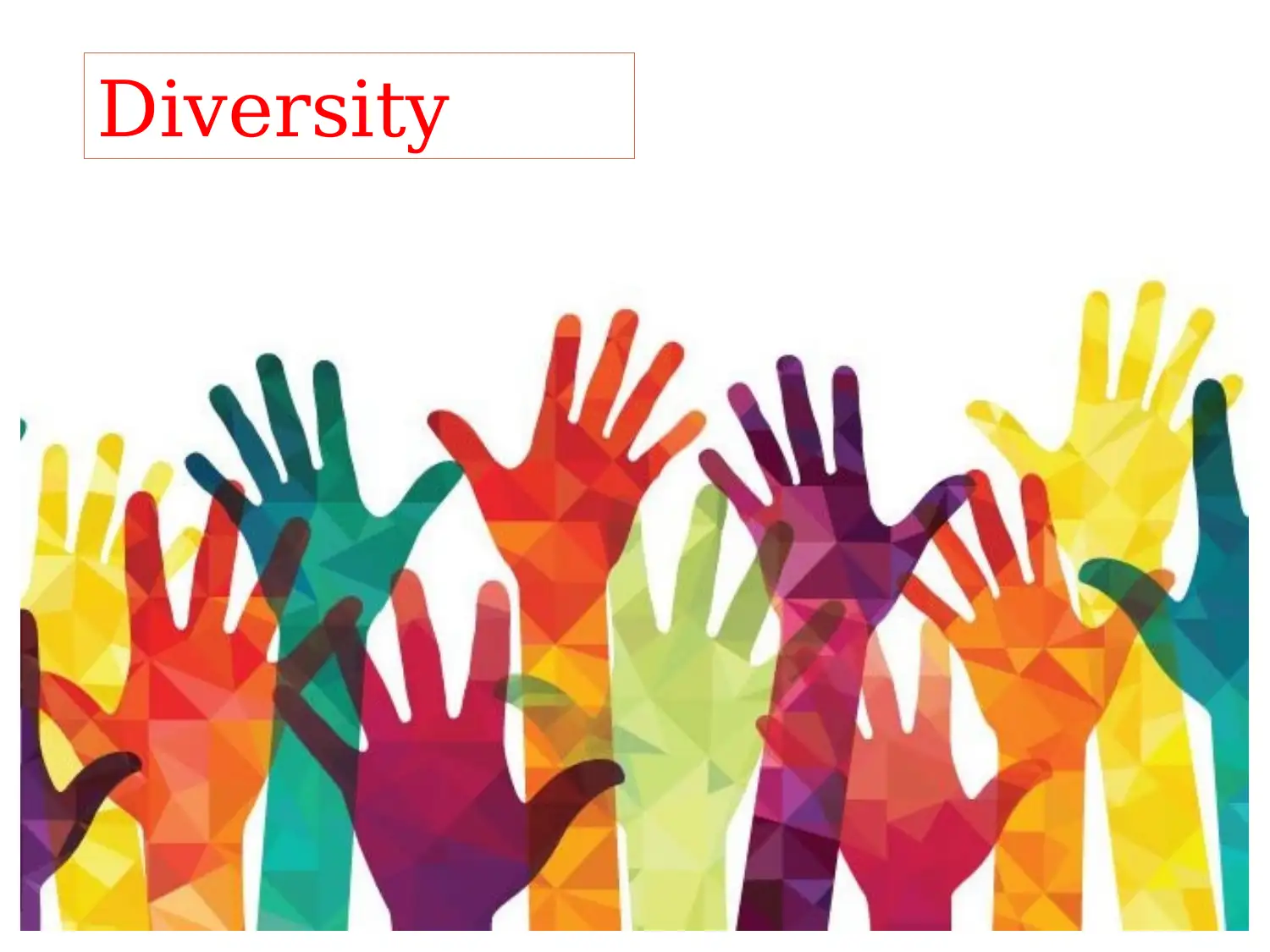
Diversity
Paraphrase This Document
Need a fresh take? Get an instant paraphrase of this document with our AI Paraphraser
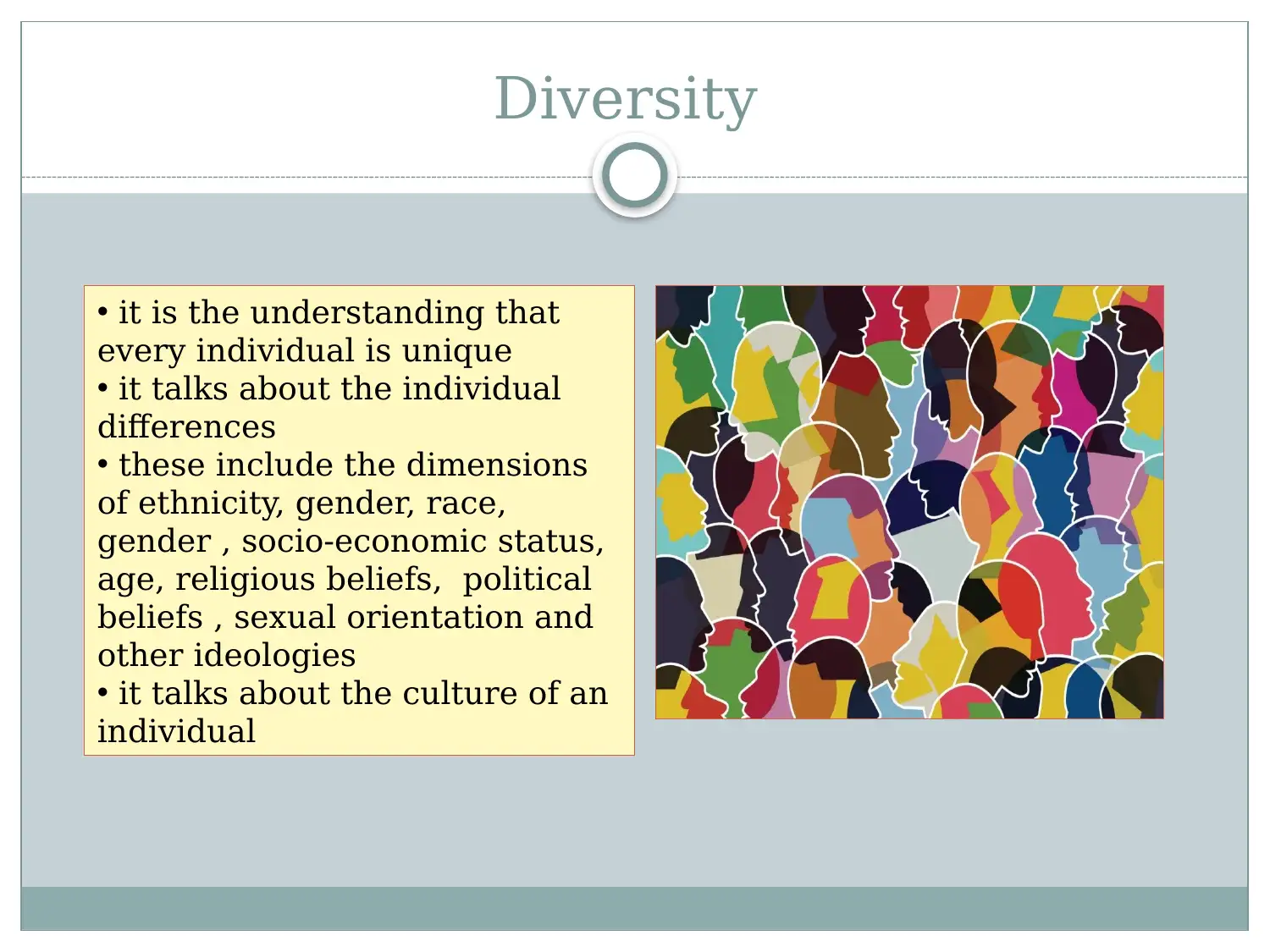
Diversity
• it is the understanding that
every individual is unique
• it talks about the individual
differences
• these include the dimensions
of ethnicity, gender, race,
gender , socio-economic status,
age, religious beliefs, political
beliefs , sexual orientation and
other ideologies
• it talks about the culture of an
individual
• it is the understanding that
every individual is unique
• it talks about the individual
differences
• these include the dimensions
of ethnicity, gender, race,
gender , socio-economic status,
age, religious beliefs, political
beliefs , sexual orientation and
other ideologies
• it talks about the culture of an
individual
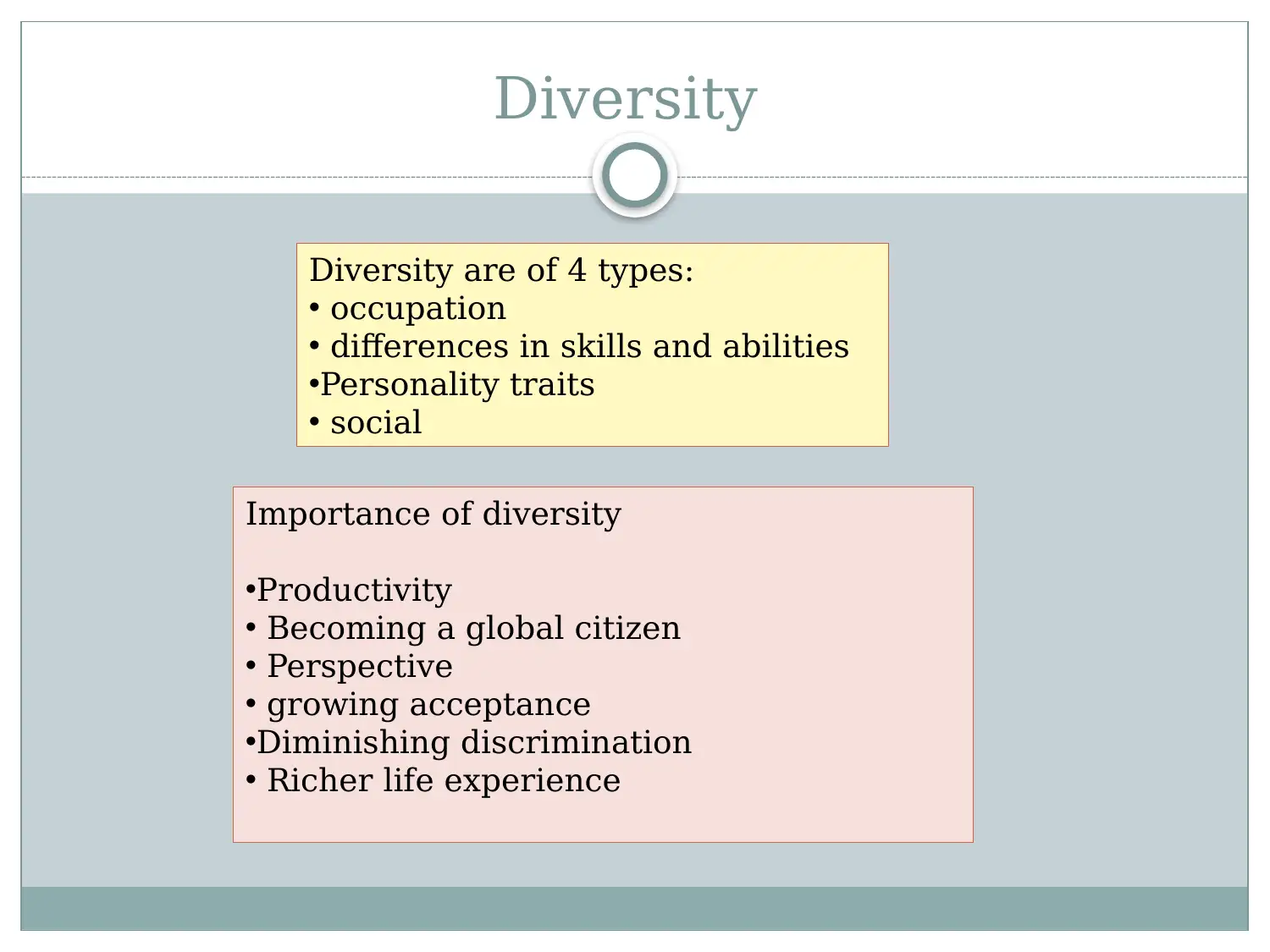
Diversity
Diversity are of 4 types:
• occupation
• differences in skills and abilities
•Personality traits
• social
Importance of diversity
•Productivity
• Becoming a global citizen
• Perspective
• growing acceptance
•Diminishing discrimination
• Richer life experience
Diversity are of 4 types:
• occupation
• differences in skills and abilities
•Personality traits
• social
Importance of diversity
•Productivity
• Becoming a global citizen
• Perspective
• growing acceptance
•Diminishing discrimination
• Richer life experience
⊘ This is a preview!⊘
Do you want full access?
Subscribe today to unlock all pages.

Trusted by 1+ million students worldwide
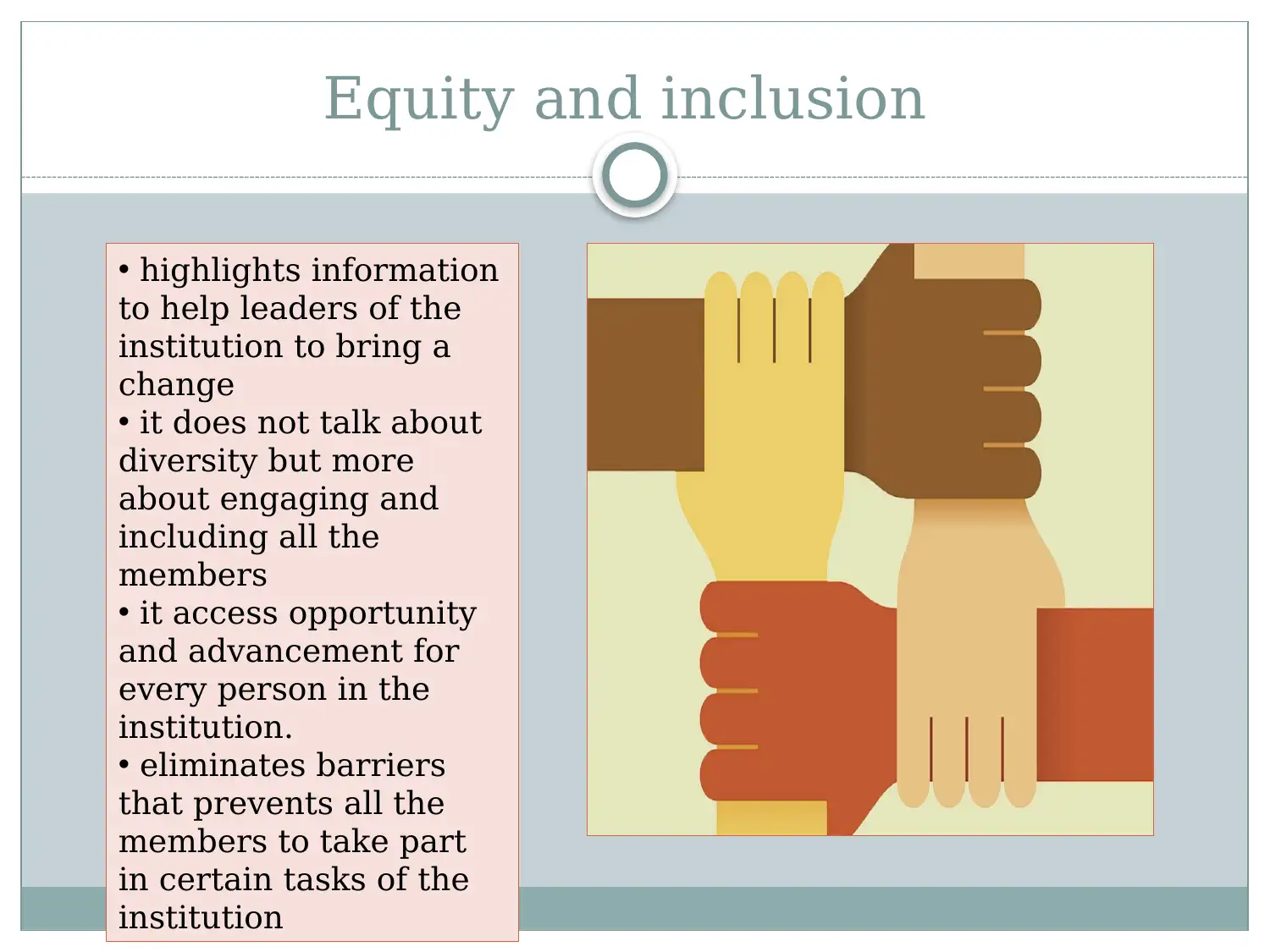
Equity and inclusion
• highlights information
to help leaders of the
institution to bring a
change
• it does not talk about
diversity but more
about engaging and
including all the
members
• it access opportunity
and advancement for
every person in the
institution.
• eliminates barriers
that prevents all the
members to take part
in certain tasks of the
institution
• highlights information
to help leaders of the
institution to bring a
change
• it does not talk about
diversity but more
about engaging and
including all the
members
• it access opportunity
and advancement for
every person in the
institution.
• eliminates barriers
that prevents all the
members to take part
in certain tasks of the
institution
Paraphrase This Document
Need a fresh take? Get an instant paraphrase of this document with our AI Paraphraser
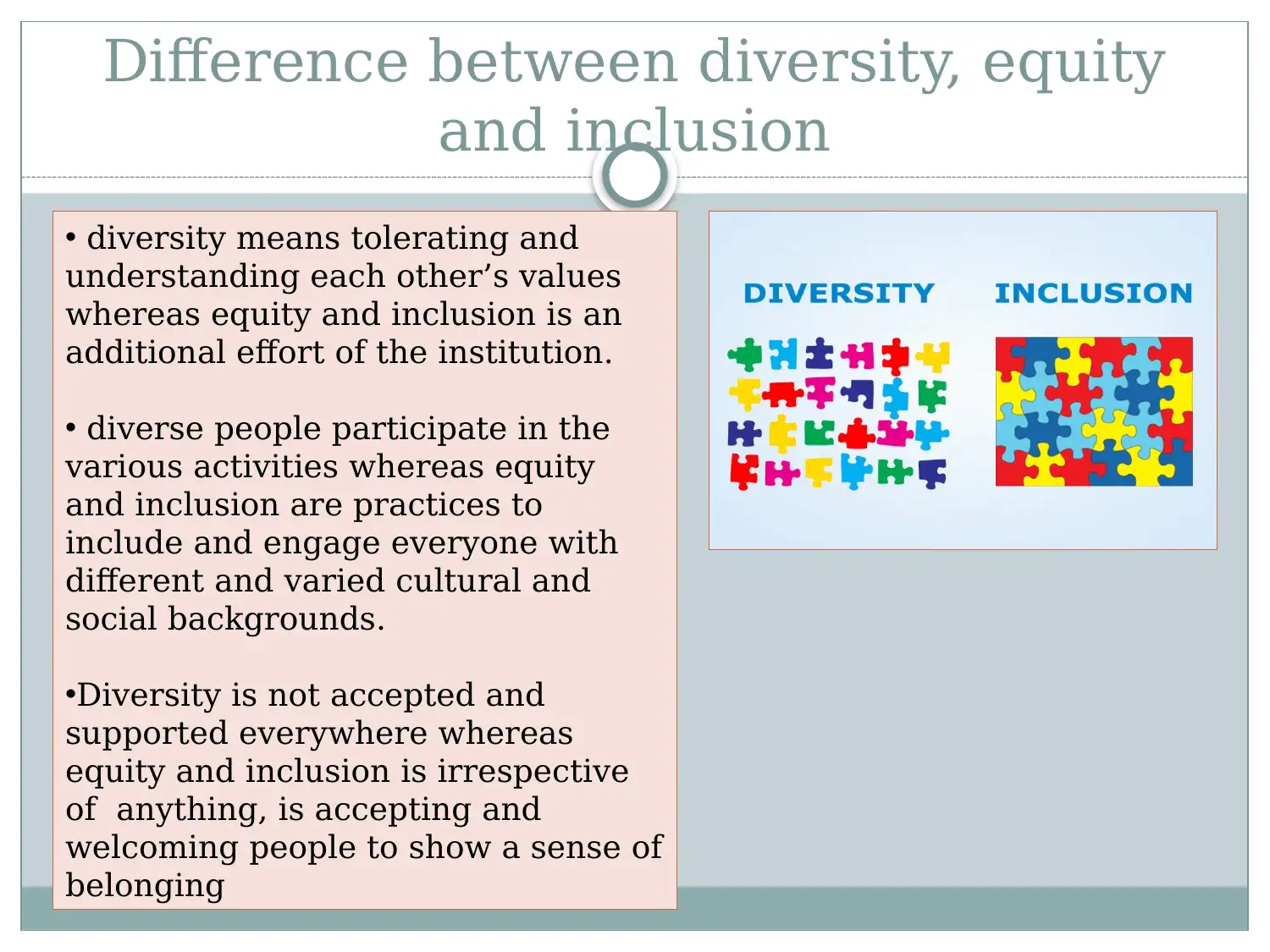
Difference between diversity, equity
and inclusion
• diversity means tolerating and
understanding each other’s values
whereas equity and inclusion is an
additional effort of the institution.
• diverse people participate in the
various activities whereas equity
and inclusion are practices to
include and engage everyone with
different and varied cultural and
social backgrounds.
•Diversity is not accepted and
supported everywhere whereas
equity and inclusion is irrespective
of anything, is accepting and
welcoming people to show a sense of
belonging
and inclusion
• diversity means tolerating and
understanding each other’s values
whereas equity and inclusion is an
additional effort of the institution.
• diverse people participate in the
various activities whereas equity
and inclusion are practices to
include and engage everyone with
different and varied cultural and
social backgrounds.
•Diversity is not accepted and
supported everywhere whereas
equity and inclusion is irrespective
of anything, is accepting and
welcoming people to show a sense of
belonging
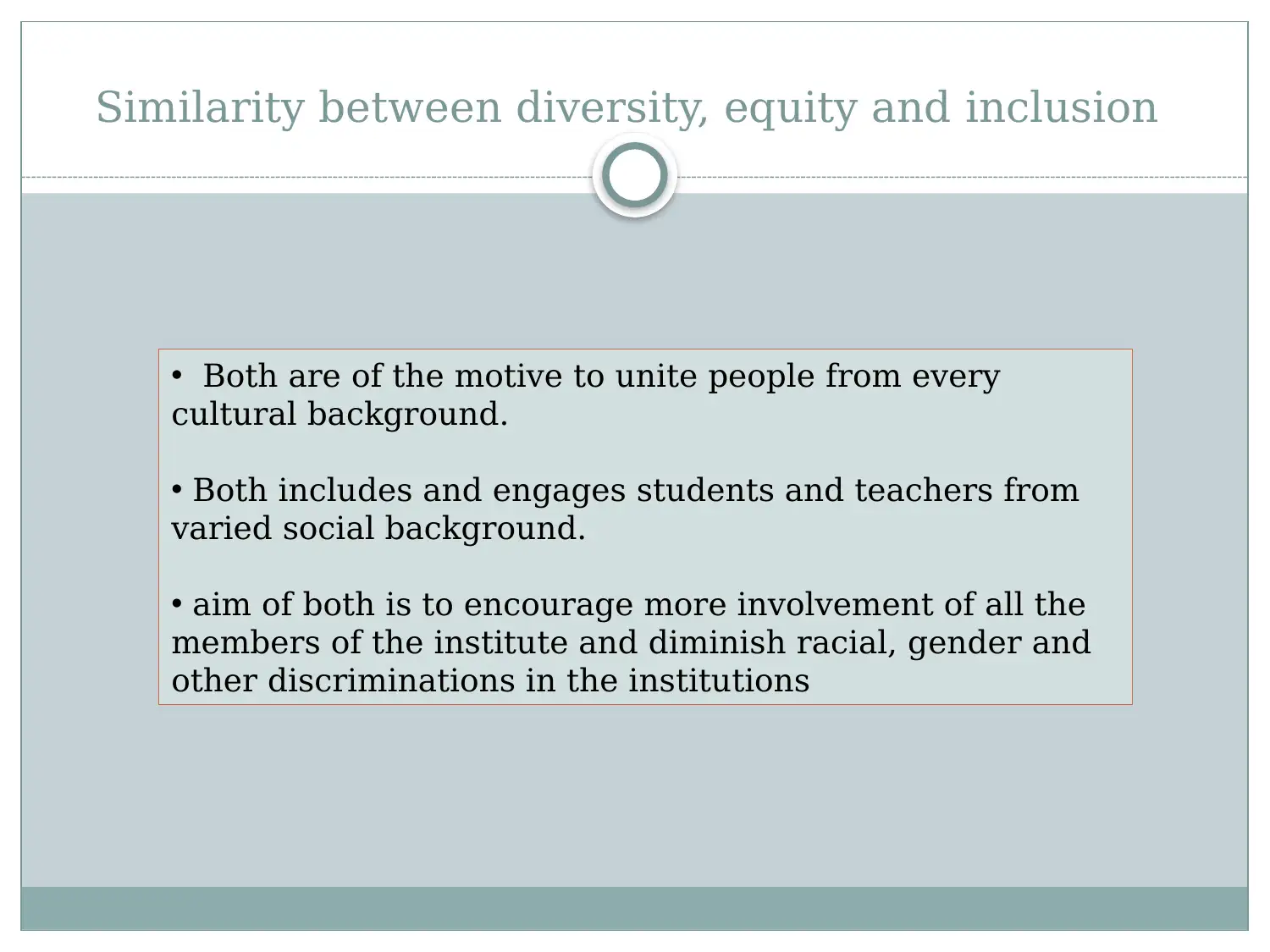
Similarity between diversity, equity and inclusion
• Both are of the motive to unite people from every
cultural background.
• Both includes and engages students and teachers from
varied social background.
• aim of both is to encourage more involvement of all the
members of the institute and diminish racial, gender and
other discriminations in the institutions
• Both are of the motive to unite people from every
cultural background.
• Both includes and engages students and teachers from
varied social background.
• aim of both is to encourage more involvement of all the
members of the institute and diminish racial, gender and
other discriminations in the institutions
⊘ This is a preview!⊘
Do you want full access?
Subscribe today to unlock all pages.

Trusted by 1+ million students worldwide
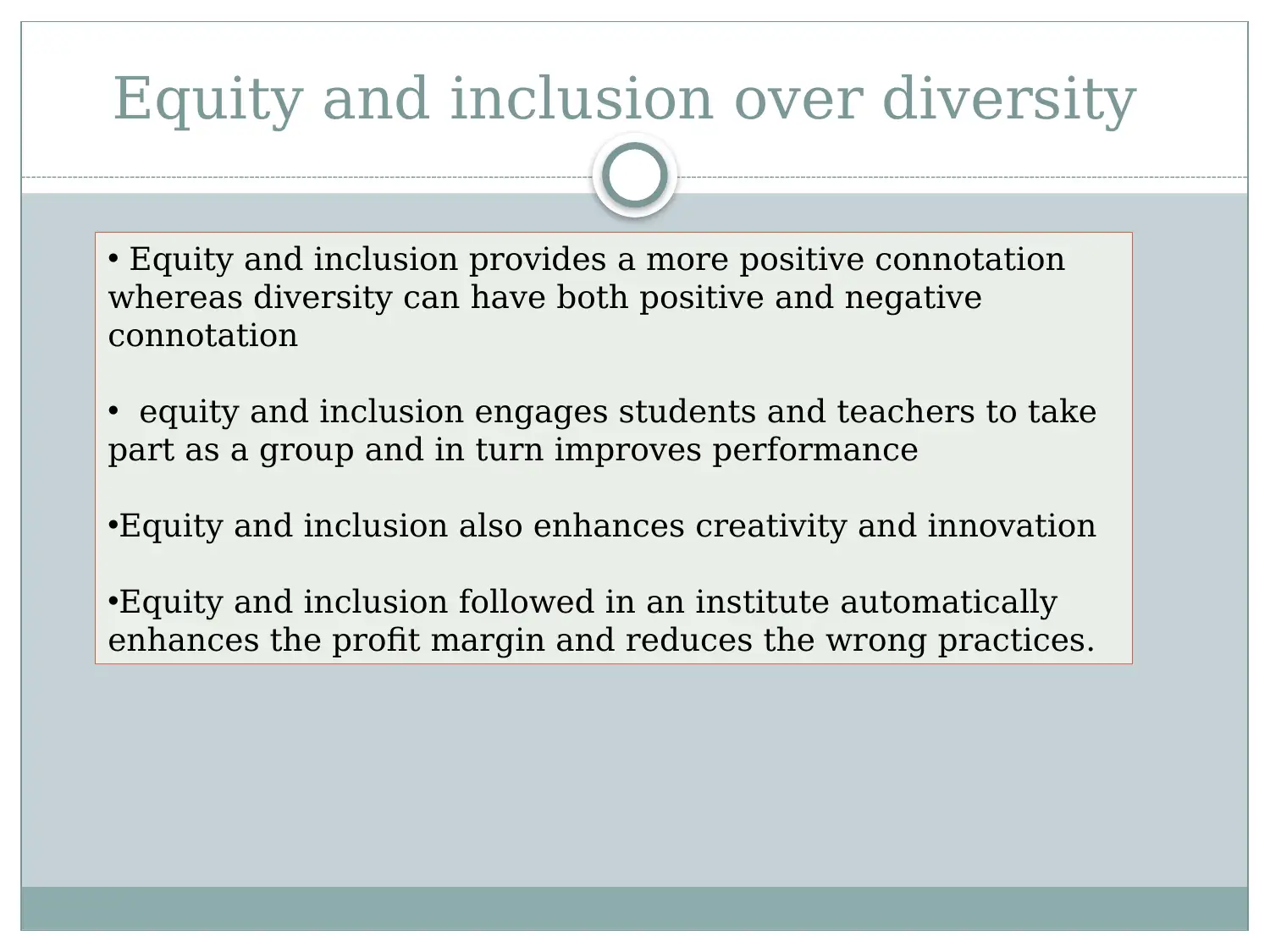
Equity and inclusion over diversity
• Equity and inclusion provides a more positive connotation
whereas diversity can have both positive and negative
connotation
• equity and inclusion engages students and teachers to take
part as a group and in turn improves performance
•Equity and inclusion also enhances creativity and innovation
•Equity and inclusion followed in an institute automatically
enhances the profit margin and reduces the wrong practices.
• Equity and inclusion provides a more positive connotation
whereas diversity can have both positive and negative
connotation
• equity and inclusion engages students and teachers to take
part as a group and in turn improves performance
•Equity and inclusion also enhances creativity and innovation
•Equity and inclusion followed in an institute automatically
enhances the profit margin and reduces the wrong practices.
Paraphrase This Document
Need a fresh take? Get an instant paraphrase of this document with our AI Paraphraser
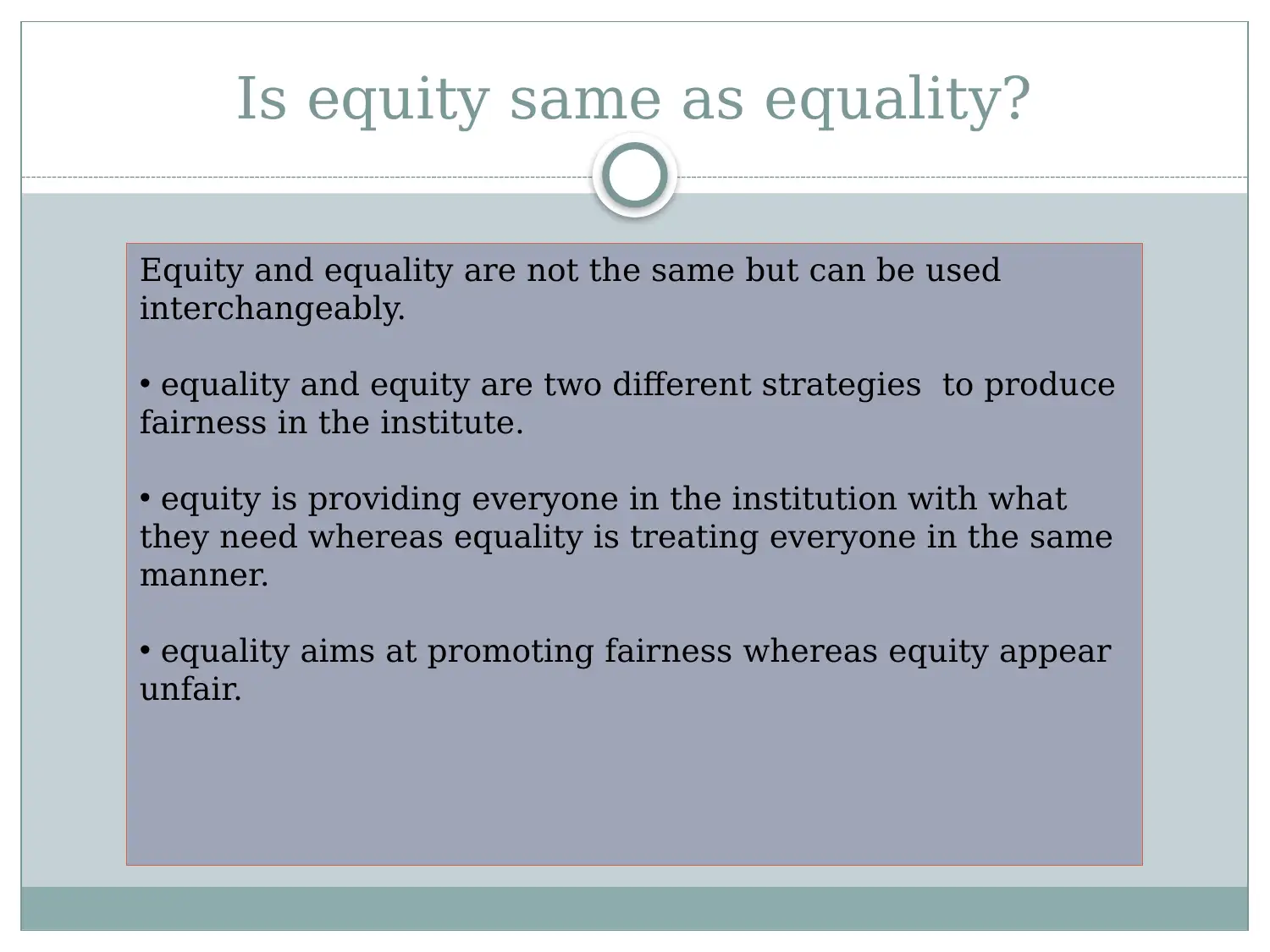
Is equity same as equality?
Equity and equality are not the same but can be used
interchangeably.
• equality and equity are two different strategies to produce
fairness in the institute.
• equity is providing everyone in the institution with what
they need whereas equality is treating everyone in the same
manner.
• equality aims at promoting fairness whereas equity appear
unfair.
Equity and equality are not the same but can be used
interchangeably.
• equality and equity are two different strategies to produce
fairness in the institute.
• equity is providing everyone in the institution with what
they need whereas equality is treating everyone in the same
manner.
• equality aims at promoting fairness whereas equity appear
unfair.
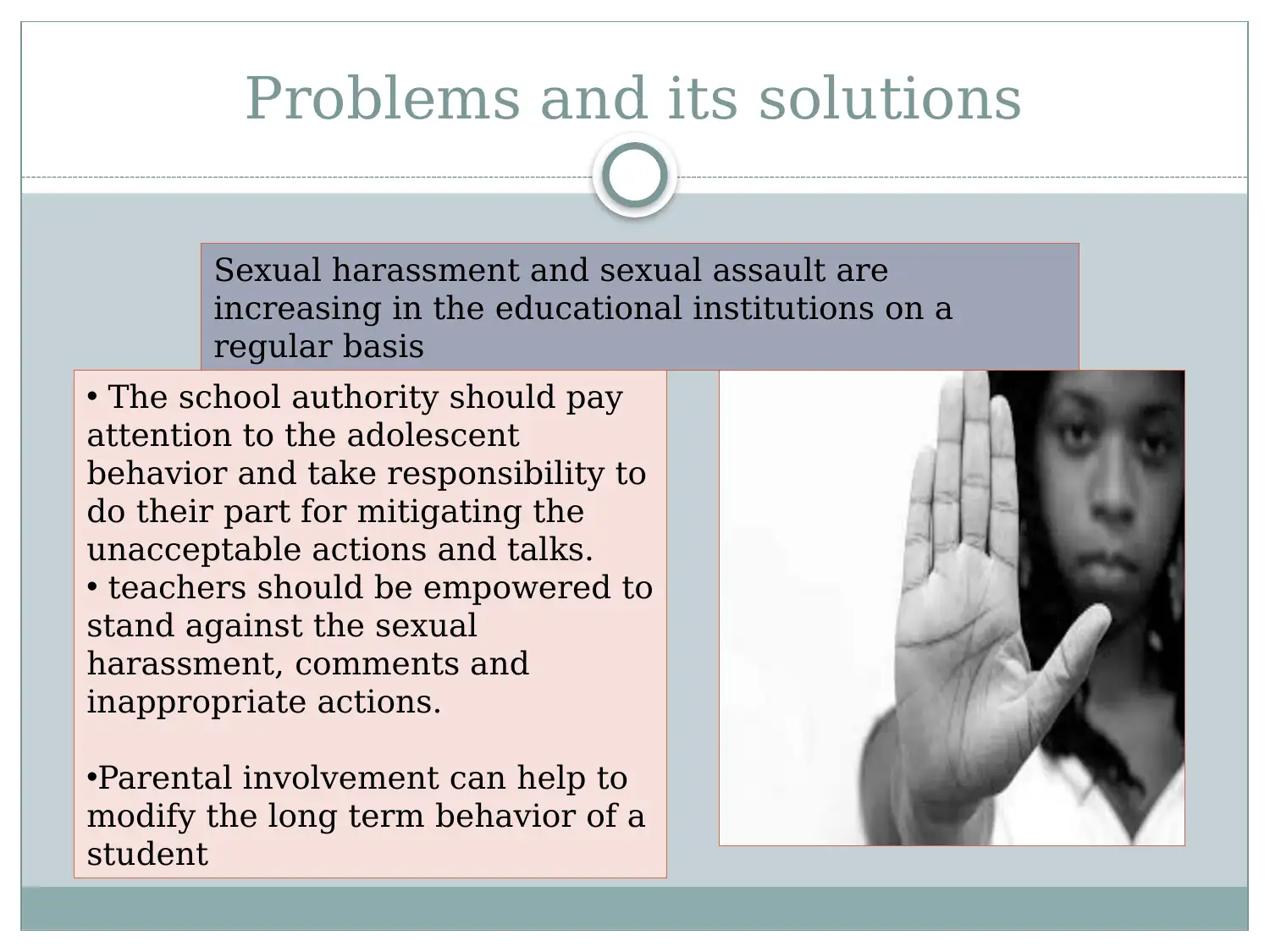
Problems and its solutions
Sexual harassment and sexual assault are
increasing in the educational institutions on a
regular basis
• The school authority should pay
attention to the adolescent
behavior and take responsibility to
do their part for mitigating the
unacceptable actions and talks.
• teachers should be empowered to
stand against the sexual
harassment, comments and
inappropriate actions.
•Parental involvement can help to
modify the long term behavior of a
student
Sexual harassment and sexual assault are
increasing in the educational institutions on a
regular basis
• The school authority should pay
attention to the adolescent
behavior and take responsibility to
do their part for mitigating the
unacceptable actions and talks.
• teachers should be empowered to
stand against the sexual
harassment, comments and
inappropriate actions.
•Parental involvement can help to
modify the long term behavior of a
student
⊘ This is a preview!⊘
Do you want full access?
Subscribe today to unlock all pages.

Trusted by 1+ million students worldwide
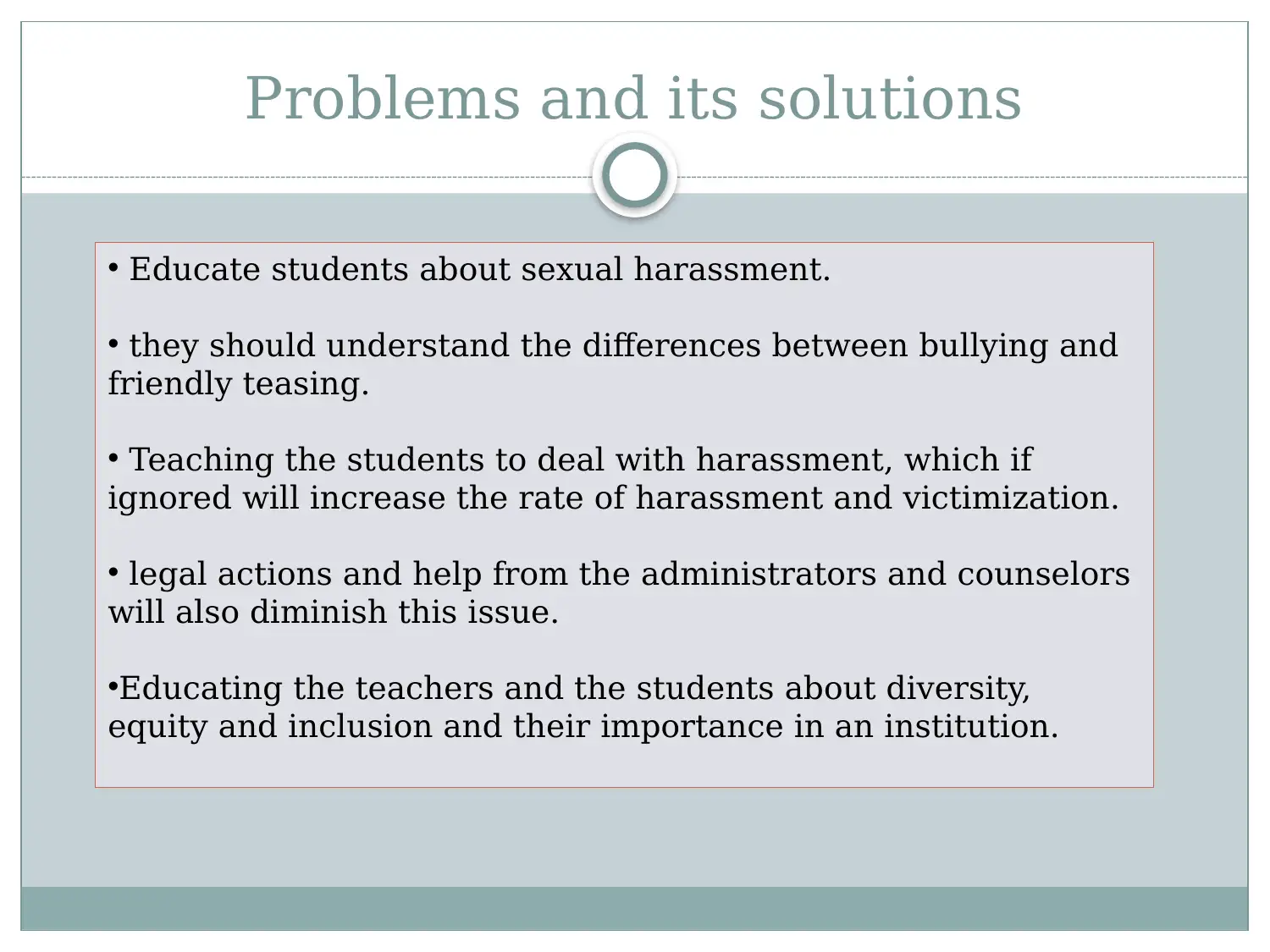
Problems and its solutions
• Educate students about sexual harassment.
• they should understand the differences between bullying and
friendly teasing.
• Teaching the students to deal with harassment, which if
ignored will increase the rate of harassment and victimization.
• legal actions and help from the administrators and counselors
will also diminish this issue.
•Educating the teachers and the students about diversity,
equity and inclusion and their importance in an institution.
• Educate students about sexual harassment.
• they should understand the differences between bullying and
friendly teasing.
• Teaching the students to deal with harassment, which if
ignored will increase the rate of harassment and victimization.
• legal actions and help from the administrators and counselors
will also diminish this issue.
•Educating the teachers and the students about diversity,
equity and inclusion and their importance in an institution.
Paraphrase This Document
Need a fresh take? Get an instant paraphrase of this document with our AI Paraphraser
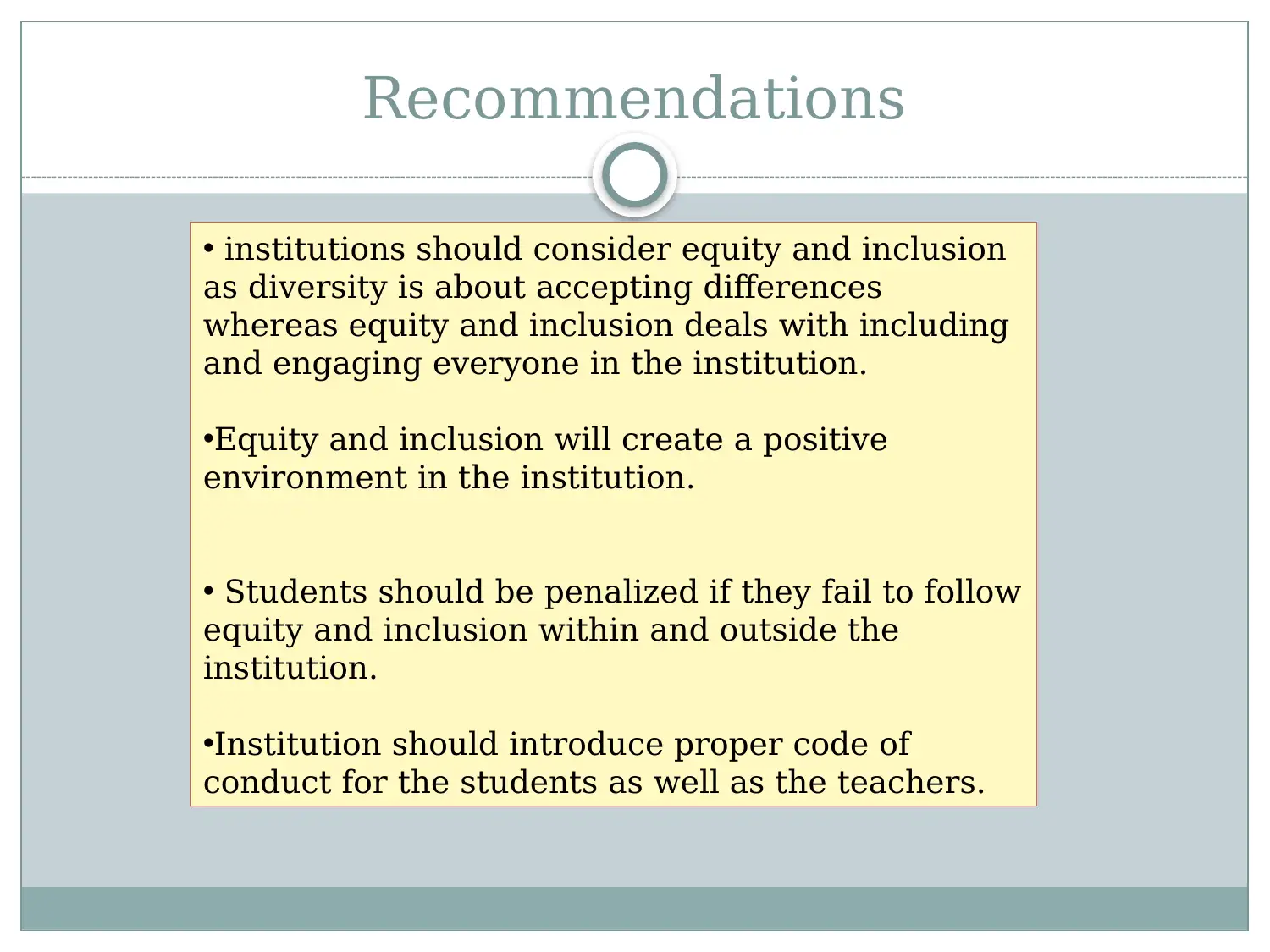
Recommendations
• institutions should consider equity and inclusion
as diversity is about accepting differences
whereas equity and inclusion deals with including
and engaging everyone in the institution.
•Equity and inclusion will create a positive
environment in the institution.
• Students should be penalized if they fail to follow
equity and inclusion within and outside the
institution.
•Institution should introduce proper code of
conduct for the students as well as the teachers.
• institutions should consider equity and inclusion
as diversity is about accepting differences
whereas equity and inclusion deals with including
and engaging everyone in the institution.
•Equity and inclusion will create a positive
environment in the institution.
• Students should be penalized if they fail to follow
equity and inclusion within and outside the
institution.
•Institution should introduce proper code of
conduct for the students as well as the teachers.
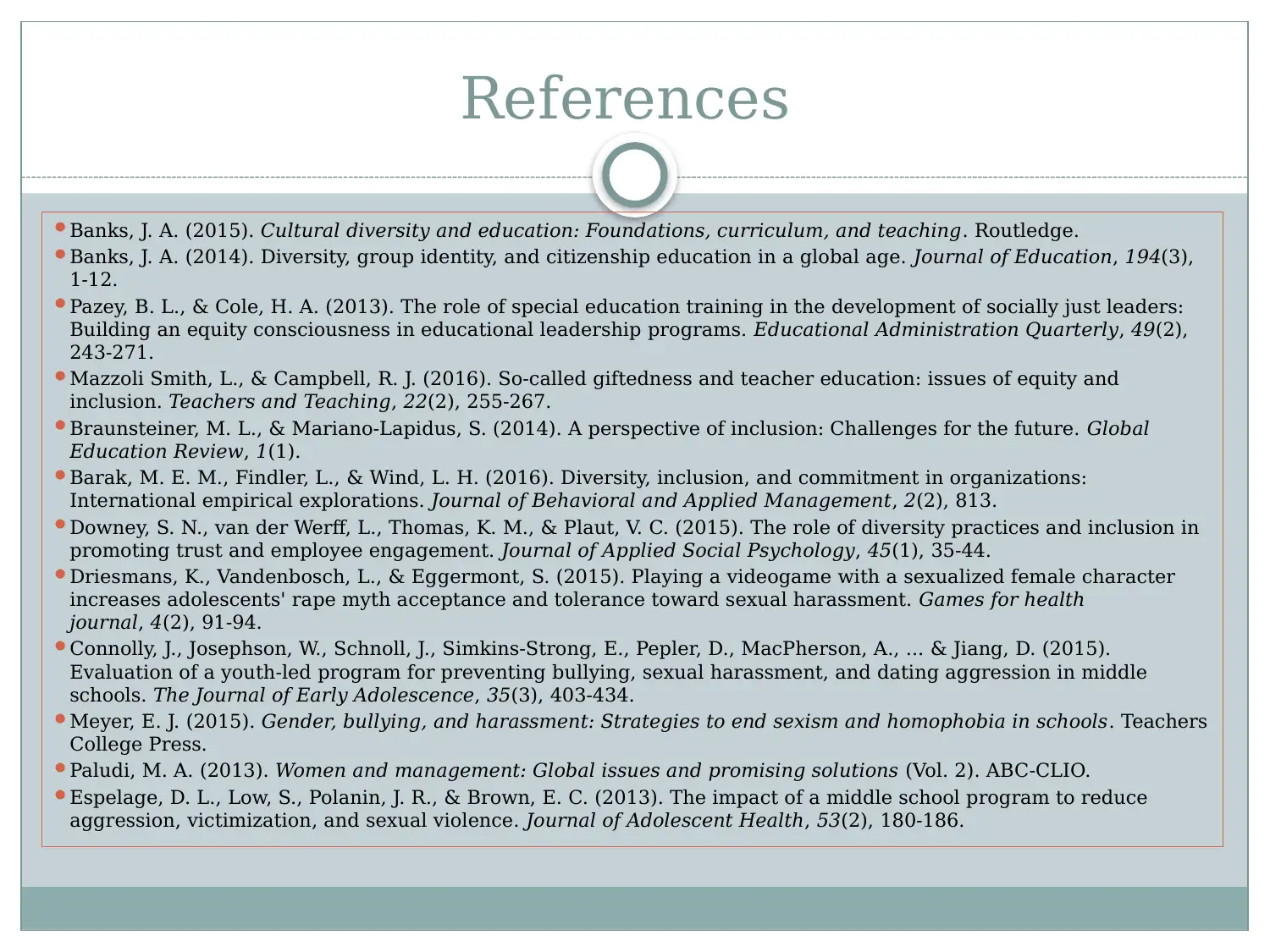
References
Banks, J. A. (2015). Cultural diversity and education: Foundations, curriculum, and teaching. Routledge.
Banks, J. A. (2014). Diversity, group identity, and citizenship education in a global age. Journal of Education, 194(3),
1-12.
Pazey, B. L., & Cole, H. A. (2013). The role of special education training in the development of socially just leaders:
Building an equity consciousness in educational leadership programs. Educational Administration Quarterly, 49(2),
243-271.
Mazzoli Smith, L., & Campbell, R. J. (2016). So-called giftedness and teacher education: issues of equity and
inclusion. Teachers and Teaching, 22(2), 255-267.
Braunsteiner, M. L., & Mariano-Lapidus, S. (2014). A perspective of inclusion: Challenges for the future. Global
Education Review, 1(1).
Barak, M. E. M., Findler, L., & Wind, L. H. (2016). Diversity, inclusion, and commitment in organizations:
International empirical explorations. Journal of Behavioral and Applied Management, 2(2), 813.
Downey, S. N., van der Werff, L., Thomas, K. M., & Plaut, V. C. (2015). The role of diversity practices and inclusion in
promoting trust and employee engagement. Journal of Applied Social Psychology, 45(1), 35-44.
Driesmans, K., Vandenbosch, L., & Eggermont, S. (2015). Playing a videogame with a sexualized female character
increases adolescents' rape myth acceptance and tolerance toward sexual harassment. Games for health
journal, 4(2), 91-94.
Connolly, J., Josephson, W., Schnoll, J., Simkins-Strong, E., Pepler, D., MacPherson, A., ... & Jiang, D. (2015).
Evaluation of a youth-led program for preventing bullying, sexual harassment, and dating aggression in middle
schools. The Journal of Early Adolescence, 35(3), 403-434.
Meyer, E. J. (2015). Gender, bullying, and harassment: Strategies to end sexism and homophobia in schools. Teachers
College Press.
Paludi, M. A. (2013). Women and management: Global issues and promising solutions (Vol. 2). ABC-CLIO.
Espelage, D. L., Low, S., Polanin, J. R., & Brown, E. C. (2013). The impact of a middle school program to reduce
aggression, victimization, and sexual violence. Journal of Adolescent Health, 53(2), 180-186.
Banks, J. A. (2015). Cultural diversity and education: Foundations, curriculum, and teaching. Routledge.
Banks, J. A. (2014). Diversity, group identity, and citizenship education in a global age. Journal of Education, 194(3),
1-12.
Pazey, B. L., & Cole, H. A. (2013). The role of special education training in the development of socially just leaders:
Building an equity consciousness in educational leadership programs. Educational Administration Quarterly, 49(2),
243-271.
Mazzoli Smith, L., & Campbell, R. J. (2016). So-called giftedness and teacher education: issues of equity and
inclusion. Teachers and Teaching, 22(2), 255-267.
Braunsteiner, M. L., & Mariano-Lapidus, S. (2014). A perspective of inclusion: Challenges for the future. Global
Education Review, 1(1).
Barak, M. E. M., Findler, L., & Wind, L. H. (2016). Diversity, inclusion, and commitment in organizations:
International empirical explorations. Journal of Behavioral and Applied Management, 2(2), 813.
Downey, S. N., van der Werff, L., Thomas, K. M., & Plaut, V. C. (2015). The role of diversity practices and inclusion in
promoting trust and employee engagement. Journal of Applied Social Psychology, 45(1), 35-44.
Driesmans, K., Vandenbosch, L., & Eggermont, S. (2015). Playing a videogame with a sexualized female character
increases adolescents' rape myth acceptance and tolerance toward sexual harassment. Games for health
journal, 4(2), 91-94.
Connolly, J., Josephson, W., Schnoll, J., Simkins-Strong, E., Pepler, D., MacPherson, A., ... & Jiang, D. (2015).
Evaluation of a youth-led program for preventing bullying, sexual harassment, and dating aggression in middle
schools. The Journal of Early Adolescence, 35(3), 403-434.
Meyer, E. J. (2015). Gender, bullying, and harassment: Strategies to end sexism and homophobia in schools. Teachers
College Press.
Paludi, M. A. (2013). Women and management: Global issues and promising solutions (Vol. 2). ABC-CLIO.
Espelage, D. L., Low, S., Polanin, J. R., & Brown, E. C. (2013). The impact of a middle school program to reduce
aggression, victimization, and sexual violence. Journal of Adolescent Health, 53(2), 180-186.
⊘ This is a preview!⊘
Do you want full access?
Subscribe today to unlock all pages.

Trusted by 1+ million students worldwide
1 out of 13
Related Documents
Your All-in-One AI-Powered Toolkit for Academic Success.
+13062052269
info@desklib.com
Available 24*7 on WhatsApp / Email
![[object Object]](/_next/static/media/star-bottom.7253800d.svg)
Unlock your academic potential
Copyright © 2020–2025 A2Z Services. All Rights Reserved. Developed and managed by ZUCOL.




